Spatio-Temporal Analysis of the Impact of Landscape Changes on Vegetation and Land Surface Temperature over Tamil Nadu
Abstract
:1. Introduction
2. Materials and Methods
2.1. Study Area
2.2. Data
2.3. Methods
2.3.1. Landuse and Landcover Classification
- Developing the N- Tree bootstrap model using satellite imageries.
- Based on DN values, develop an unpruned classification for each bootstrap model.
- In terms of DN values, gather the N-number of polygons.
- Select the number of classifications for land-use classes.
- Generate results of land-use classification.
2.3.2. Normalized Difference Vegetation Index (NDVI)
2.3.3. Soil Adjusted Vegetation Index (SAVI)
2.3.4. Land Surface Temperature (LST)
- LMAX = the spectral radiance that is scaled to QCALMAX in W/(m2 *sr *μm)
- LMIN = the spectral radiance that is scaled to QCALMIN in W/(m2 *sr *μm)
- QCALMAX = the maximum quantized calibrated pixel value (corresponding to LMAX) in DN = 255
- QCALMIN = the minimum quantized calibrated pixel value (corresponding to LMIN) in DN = 1
2.3.5. Vegetation Condition Index (VCI)—Drought Intensity and Temperature Condition Index
2.3.6. Temperature Condition Index (TCI)
2.3.7. Vegetation Health Index (VHI)
3. Results
3.1. Analyzing the Landuse Landcover Changes
3.2. Assessment of Vegetation Health
3.3. Soil Moisture Assessment
3.4. Calculating Land Surface Temperature
3.5. Comparative Study between NDVI, SAVI, and LST Associated with Each LULC Class
3.6. Assessing the Drought Intensity for 2020
3.7. Monitoring the Vegetation Health by VHI
3.8. Comparative Study between VCI, VHI, and LST Associated with Each LULC Class
4. Discussion
5. Conclusions
Supplementary Materials
Author Contributions
Funding
Data Availability Statement
Conflicts of Interest
References
- Ilman, M.; Dargusch, P.; Dart, P.; Onrizal. A historical analysis of the drivers of loss and degradation of Indonesia’s mangroves. Land Use Policy 2016, 54, 10. [Google Scholar] [CrossRef]
- Verburg, P.H.; Kok, K.; Pontius, R.G.; Veldkamp, A. Modeling Land-Use and Land-Cover Change. In Land-Use and Land-Cover Change; Springer: Berlin/Heidelberg, Germany, 2006; pp. 117–135. [Google Scholar]
- Geist, H.; McConnell, W.; Lambin, E.F.; Moran, E.; Alves, D.; Rudel, T. Causes and Trajectories of Land-Use/Cover Change. In Land-Use and Land-Cover Change; Springer: Berlin/Heidelberg, Germany, 2008; pp. 41–70. [Google Scholar]
- Chauhan, N.; Kumar, V.; Paliwal, R. Quantifying the impacts of decadal landuse change on the water balance components using soil and water assessment tool in Ghaggar river basin. SN Appl. Sci. 2020, 2, 60. [Google Scholar] [CrossRef]
- Mundia, C.N.; Aniya, M. Dynamics of landuse/cover changes and degradation of Nairobi City, Kenya. Land Degrad. Dev. 2006, 17, 97–108. [Google Scholar] [CrossRef]
- Hamilton, S.E.; Casey, D. Creation of a high spatio-temporal resolution global database of continuous mangrove forest cover for the 21st century (CGMFC-21). Glob. Ecol. Biogeogr. 2016, 25, 729–738. [Google Scholar] [CrossRef]
- Whitehead, P.G.; Barbour, E.; Futter, M.N.; Sarkar, S.; Rodda, H.; Caesar, J.; Butterfield, D.; Jin, L.; Sinha, R.; Nicholls, R.; et al. Impacts of climate change and socio-economic scenarios on flow and water quality of the Ganges, Brahmaputra and Meghna (GBM) river systems: Low flow and flood statistics. Environ. Sci. Process. Impacts 2015, 17, 1057–1069. [Google Scholar] [CrossRef]
- Ward, K.; Lauf, S.; Kleinschmit, B.; Endlicher, W. Heat waves and urban heat islands in Europe: A review of relevant drivers. Sci. Total Environ. 2016, 569–570, 527–539. [Google Scholar] [CrossRef]
- Tran, H.; Uchihama, D.; Ochi, S.; Yasuoka, Y. Assessment with satellite data of the urban heat island effects in Asian mega cities. Int. J. Appl. Earth Obs. Geoinf. 2006, 8, 34–48. [Google Scholar] [CrossRef]
- Tariq, A.; Shu, H. CA-Markov chain analysis of seasonal land surface temperature and land use landcover change using optical multi-temporal satellite data of Faisalabad, Pakistan. Remote Sens. 2020, 12, 3402. [Google Scholar] [CrossRef]
- Orusa, T.; Orusa, R.; Viani, A.; Carella, E.; Mondino, E.B. Geomatics and EO data to support wildlife diseases assessment at landscape level: A pilot experience to map infectious keratoconjunctivitis in chamois and phenological trends in Aosta Valley (NW Italy). Remote Sens. 2020, 12, 3542. [Google Scholar] [CrossRef]
- Padmanaban, R.; Bhowmik, A.K.; Cabral, P.; Zamyatin, A.; Almegdadi, O.; Wang, S. Modelling urban sprawl using remotely sensed data: A case study of Chennai city, Tamilnadu. Entropy 2017, 19, 163. [Google Scholar] [CrossRef] [Green Version]
- Moody, E.G.; King, M.D.; Schaaf, C.B.; Hall, D.K.; Platnick, S. Northern Hemisphere five-year average (2000-2004) spectral albedos of surfaces in the presence of snow: Statistics computed from Terra MODIS land products. Remote Sens. Environ. 2007, 111, 337–345. [Google Scholar] [CrossRef]
- de Costa Trindade Amorim, M.C. Spatial variability and intensity frequency of surface heat island in a Brazilian city with continental tropical climate through remote sensing. Remote Sens. Appl. Soc. Environ. 2018, 9, 10–16. [Google Scholar]
- Douglas, I. Ecosystems and Human Well-Being. In Encyclopedia of the Anthropocene; Elsevier: Amsterdam, The Netherlands, 2017; Volume 1–5, pp. 185–197. [Google Scholar]
- Li, Z.L.; Tang, B.H.; Wu, H.; Ren, H.; Yan, G.; Wan, Z.; Trigo, I.F.; Sobrino, J.A. Satellite-derived land surface temperature: Current status and perspectives. Remote Sens. Environ. 2013, 131, 14–37. [Google Scholar] [CrossRef] [Green Version]
- Orusa, T.; Borgogno Mondino, E. Landsat 8 thermal data to support urban management and planning in the climate change era: A case study in Torino area, NW Italy. Environ. Sci. 2019, 11157, 4. [Google Scholar]
- Flores, R.J.L.; Pereira Filho, A.J.; Karam, H.A. Estimation of long term low resolution surface urban heat island intensities for tropical cities using MODIS remote sensing data. Urban Clim. 2016, 17, 32–66. [Google Scholar] [CrossRef]
- Ermida, S.L.; Soares, P.; Mantas, V.; Göttsche, F.M.; Trigo, I.F. Google earth engine open-source code for land surface temperature estimation from the landsat series. Remote Sens. 2020, 12, 1471. [Google Scholar] [CrossRef]
- Naughton, J.; McDonald, W. Evaluating the variability of urban land surface temperatures using drone observations. Remote Sens. 2019, 11, 1722. [Google Scholar] [CrossRef] [Green Version]
- Padmanban, R.; Painho, M. Urban Agent Based Model of Urban SlumDharavi, Mumbai, India. J. Earth Syst. Sci. Eng. 2017, 2, 1110. [Google Scholar]
- Dandona, L.; Dandona, R.; John, R.K.; McCarty, C.A.; Rao, G.N. Population based assessment of uveitis in an urban population in southern India. Br. J. Ophthalmol. 2000, 84, 706–709. [Google Scholar] [CrossRef] [Green Version]
- Usmani, G.; Ahmad, N. Health status in India: A study of urban slum and non-slum population. J. Nurs Res. Pract. 2018, 2, 9–14. [Google Scholar]
- Anees, M.M.; Shukla, R.; Punia, M.; Joshi, P.K. Assessment and visualization of inherent vulnerability of urban population in India to natural disasters. Clim. Dev. 2020, 12, 532–546. [Google Scholar] [CrossRef]
- Balk, D.; Montgomery, M.R.; Engin, H.; Lin, N.; Major, E.; Jones, B. Urbanization in India: Population and urban classification grids for 2011. Data 2019, 4, 35. [Google Scholar] [CrossRef] [Green Version]
- Wu, D.C.N.; Banzon, E.P.; Gelband, H.; Chin, B.; Malhotra, V.; Khetrapal, S.; Watkins, D.; Ra, S.; Jamison, D.T.; Jha, P. Health-care investments for the urban populations, bangladesh and india. Bull. World Health Organ. 2020, 98, 19–29. [Google Scholar] [CrossRef]
- Anuradha, B.; Iyappan, L.; Partheeban, P.; Jaganmogan, K.; Hariharasudan, C.; Palanikumar, K. Statistical study on area cultivated in peri-urban and rural tanks during pre and post rehabilitation. Int. J. Agric. Stat. Sci. 2020, 16, 883–888. [Google Scholar]
- Mohanraj, R.; Sathishkumar, M.; Azeez, P.A.; Sivakumar, R. Pollution status of wetlands in urban Coimbatore, Tamilnadu, India. Bull. Environ. Contam. Toxicol. 2000, 64, 638–643. [Google Scholar] [CrossRef]
- Kiruthiga, K.; Thirumaran, K. Effects of urbanization on historical heritage buildings in Kumbakonam, Tamilnadu, India. Front. Archit. Res. 2019, 8, 94–105. [Google Scholar] [CrossRef]
- Samuel, P.; Antonisamy, B.; Raghupathy, P.; Richard, J.; Fall, C.H.D. Socio-economic status and cardiovascular risk factors in rural and urban areas of Vellore, Tamilnadu, South India. Int. J. Epidemiol. 2012, 41, 1315–1327. [Google Scholar] [CrossRef] [Green Version]
- Padmanaban, R.; Karuppasamy, S.; Narayanan, R. Assessment of pollutant level and forecasting water pollution of Chennai coastal, TamilNadu using R. Indian J. Geo-Mar. Sci. 2018, 47, 1420–1429. [Google Scholar]
- Cabral, P.; Feger, C.; Levrel, H.; Chambolle, M.; Basque, D. Assessing the impact of land-cover changes on ecosystem services: A first step toward integrative planning in Bordeaux, France. Ecosyst. Serv. 2016, 22, 318–327. [Google Scholar] [CrossRef] [Green Version]
- Shuangao, W.; Padmanaban, R.; Mbanze, A.A.; Silva, J.M.N.; Shamsudeen, M.; Cabral, P.; Campos, F.S. Using satellite image fusion to evaluate the impact of land use changes on ecosystem services and their economic values. Remote Sens. 2021, 13, 851. [Google Scholar] [CrossRef]
- Padmanaban, R.; Bhowmik, A.K.; Cabral, P. Satellite image fusion to detect changing surface permeability and emerging urban heat islands in a fast-growing city. PLoS ONE 2019, 14, e0208949. [Google Scholar] [CrossRef] [PubMed]
- Su, S.; Xiao, R.; Jiang, Z.; Zhang, Y. Characterizing landscape pattern and ecosystem service value changes for urbanization impacts at an eco-regional scale. Appl. Geogr. 2012, 34, 295–305. [Google Scholar] [CrossRef]
- Charrua, A.B.; Padmanaban, R.; Cabral, P.; Bandeira, S.; Romeiras, M.M. Impacts of the Tropical Cyclone Idai in Mozambique: A Multi-Temporal Landsat Satellite Imagery Analysis. Remote Sens. 2021, 13, 201. [Google Scholar] [CrossRef]
- Mateo-García, G.; Gómez-Chova, L.; Amorós-López, J.; Muñoz-Marí, J.; Camps-Valls, G. Multitemporal cloud masking in the Google Earth Engine. Remote Sens. 2018, 10, 1079. [Google Scholar] [CrossRef] [Green Version]
- Chidambaram, S.; Karmegam, U.; Prasanna, M.V.; Sasidhar, P. A study on evaluation of probable sources of heavy metal pollution in groundwater of Kalpakkam region, South India. Environmentalist 2012, 32, 371–382. [Google Scholar] [CrossRef]
- Kumar, L.; Mutanga, O. Google Earth Engine applications since inception: Usage, trends, and potential. Remote Sens. 2018, 10, 1509. [Google Scholar] [CrossRef] [Green Version]
- Tan, Z.; Guan, Q.; Lin, J.; Yang, L.; Luo, H.; Ma, Y.; Tian, J.; Wang, Q.; Wang, N. The response and simulation of ecosystem services value to land use/land cover in an oasis, Northwest China. Ecol. Indic. 2020, 118, 711. [Google Scholar] [CrossRef]
- Schirpke, U.; Tscholl, S.; Tasser, E. Spatio-temporal changes in ecosystem service values: Effects of land-use changes from past to future (1860–2100). J. Environ. Manag. 2020, 272, 111068. [Google Scholar] [CrossRef]
- Sil, Â.; Fonseca, F.; Gonçalves, J.; Honrado, J.; Marta-Pedroso, C.; Alonso, J.; Ramos, M.; Azevedo, J.C. Analysing carbon sequestration and storage dynamics in a changing mountain landscape in Portugal: Insights for management and planning. Int. J. Biodivers. Sci. Ecosyst. Serv. Manag. 2017, 13, 82–104. [Google Scholar] [CrossRef] [Green Version]
- Xu, P.; Jin, P.; Yang, Y.; Wang, Q. Evaluating Urbanization and Spatial-Temporal Pattern Using the DMSP/OLS Nighttime Light Data: A Case Study in Zhejiang Province. Math. Probl. Eng. 2016, 2016, 890. [Google Scholar] [CrossRef] [Green Version]
- Dewan, A.; Kiselev, G.; Botje, D.; Mahmud, G.I.; Bhuian, M.H.; Hassan, Q.K. Surface urban heat island intensity in five major cities of Bangladesh: Patterns, drivers and trends. Sustain. Cities Soc. 2021, 71, 102926. [Google Scholar] [CrossRef]
- Tang, Q.; Wang, J.; Jing, Z.; Yan, Y.; Niu, H. Response of ecological vulnerability to land use change in a resource-based city, China. Resour. Policy 2021, 74, 102324. [Google Scholar] [CrossRef]
- Nivedita Priyadarshini, K.; Sivashankari, V.; Shekhar, S. An assessment of Land Cover Change Dynamics of Gaja Cyclone in Coastal Tamil Nadu, India Using Sentinel 1 SAR Dataset. In International Archives of the Photogrammetry, Remote Sensing and Spatial Information Sciences—ISPRS Archives; ISPRS: Hannover, Germany, 2019; Volume 42. [Google Scholar]
- Muthusamy, S.; Sivakumar, K.; Durai, A.; Sheriff, M. Ockhi Cyclone and its Impact in the Kanyakumari District of Southern Tamilnadu, India: An Aftermath Analysis. Int. J. Recent Res. Asp. 2018, 1, 466–469. [Google Scholar]
- Bangaru Kamatchi, S.; Parvathi, R. Analysis of timeseries forecasting models using Tamilnadu environmental weather data. J. Green Eng. 2020, 10, 1208–1217. [Google Scholar]
- Kennedy, R.E.; Yang, Z.; Gorelick, N.; Braaten, J.; Cavalcante, L.; Cohen, W.B.; Healey, S. Implementation of the LandTrendr algorithm on Google Earth Engine. Remote Sens. 2018, 10, 691. [Google Scholar] [CrossRef] [Green Version]
- GEE Earth Engine Data Catalog. Available online: https://developers.google.com/earth-engine/datasets/catalog/ (accessed on 4 January 2020).
- Geist, H.; McConnell, W.; Lambin, E.F.; Moran, E.; Alves, D.; Rudel, T. Land-Use and Land-Cover Change; Springer: Berlin/Heidelberg, Germany, 2006. [Google Scholar]
- Breiman, L. Random forests. Mach. Learn. 2001, 45, 5–32. [Google Scholar] [CrossRef] [Green Version]
- Pal, M. Random forest classifier for remote sensing classification. Int. J. Remote Sens. 2005, 26, 217–222. [Google Scholar] [CrossRef]
- Svetnik, V.; Liaw, A.; Tong, C.; Christopher Culberson, J.; Sheridan, R.P.; Feuston, B.P. Random Forest: A Classification and Regression Tool for Compound Classification and QSAR Modeling. J. Chem. Inf. Comput. Sci. 2003, 43, 1947–1958. [Google Scholar] [CrossRef]
- Reichardt, J.; Bornholdt, S. Statistical mechanics of community detection. Phys. Rev. E–Stat. Nonlinear Soft Matter Phys. 2006, 74, 1–27. [Google Scholar] [CrossRef] [Green Version]
- Özçift, A. Random forests ensemble classifier trained with data resampling strategy to improve cardiac arrhythmia diagnosis. Comput. Biol. Med. 2011, 41, 265–271. [Google Scholar] [CrossRef]
- Gao, J. A hybrid method toward accurate mapping of mangroves in a marginal habitat from spot multispectral data. Int. J. Remote Sens. 1998, 19, 1887–1899. [Google Scholar] [CrossRef]
- Islami, F.A.; Tarigan, S.D.; Wahjunie, E.D.; Dasanto, B.D. Accuracy Assessment of Land Use Change Analysis Using Google Earth in Sadar Watershed Mojokerto Regency. IOP Conf. Ser. Earth Environ. Sci. 2022, 950, 9. [Google Scholar] [CrossRef]
- Aubard, V.; Paulo, J.A.; Silva, J.M.N. Long-term monitoring of cork and holm oak stands productivity in Portugal with Landsat imagery. Remote Sens. 2019, 11, 525. [Google Scholar] [CrossRef] [Green Version]
- Ruiz-Luna, A.; Berlanga-Robles, C.A. Modifications in Coverage Patterns and Land Use around the Huizache-Caimanero Lagoon System, Sinaloa, Mexico: A Multi-temporal Analysis using LANDSAT Images. Estuar. Coast. Shelf Sci. 1999, 49, 37–44. [Google Scholar] [CrossRef] [Green Version]
- Bhowmik, A.K.; Cabral, P. Cyclone Sidr Impacts on the Sundarbans Floristic Diversity. Earth Sci. Res. 2013, 2, 62–79. [Google Scholar] [CrossRef] [Green Version]
- Padmanaban, R.; Bhowmik, A.K.; Cabral, P. A remote sensing approach to environmental monitoring in a reclaimed mine area. ISPRS Int. J. Geo-Inf. 2017, 6, 401. [Google Scholar] [CrossRef] [Green Version]
- Son, N.T.; Chen, C.F.; Chen, C.R. Mapping Mangrove Density from Rapideye Data in Central America. Open Geosci. 2017, 9, 18. [Google Scholar] [CrossRef] [Green Version]
- Meza Diaz, B.; Blackburn, G.A. Remote sensing of mangrove biophysical properties: Evidence from a laboratory simulation of the possible effects of background variation on spectral vegetation indices. Int. J. Remote Sens. 2003, 24, 53–73. [Google Scholar] [CrossRef]
- Zhen, Z.; Chen, S.; Yin, T.; Chavanon, E.; Lauret, N.; Guilleux, J.; Henke, M.; Qin, W.; Cao, L.; Li, J.; et al. Using the negative soil adjustment factor of soil adjusted vegetation index (Savi) to resist saturation effects and estimate leaf area index (lai) in dense vegetation areas. Sensors 2021, 21, 2115. [Google Scholar] [CrossRef]
- Rondeaux, G.; Steven, M.; Baret, F. Optimization of soil-adjusted vegetation indices. Remote Sens. Environ. 1996, 55, 95–107. [Google Scholar] [CrossRef]
- Huete, A.R. A soil-adjusted vegetation index (SAVI). Remote Sens. Environ. 1988, 25, 295–309. [Google Scholar] [CrossRef]
- Jung, M.C.; Dyson, K.; Alberti, M. Urban Landscape Heterogeneity Influences the Relationship between Tree Canopy and Land Surface Temperature. Urban For. Urban Green. 2021, 57, 126930. [Google Scholar] [CrossRef]
- Batbaatar, J.; Gillespie, A.R.; Sletten, R.S.; Mushkin, A.; Amit, R.; Liaudat, D.T.; Liu, L.; Petrie, G. Toward the detection of permafrost using land-surface temperature mapping. Remote Sens. 2020, 12, 695. [Google Scholar] [CrossRef] [Green Version]
- Pei, F.; Wu, C.; Liu, X.; Li, X.; Yang, K.; Zhou, Y.; Wang, K.; Xu, L.; Xia, G. Monitoring the vegetation activity in China using vegetation health indices. Agric. For. Meteorol. 2018, 248, 215–227. [Google Scholar] [CrossRef]
- Möllmann, J.; Buchholz, M.; Kölle, W.; Musshoff, O. Do remotely-sensed vegetation health indices explain credit risk in agricultural microfinance? World Dev. 2020, 127, 104771. [Google Scholar] [CrossRef] [Green Version]
- Liang, L.; Sun, Q.; Luo, X.; Wang, J.; Zhang, L.; Deng, M.; Di, L.; Liu, Z. Long-term spatial and temporal variations of vegetative drought based on vegetation condition index in China. Ecosphere 2017, 8, e01919. [Google Scholar] [CrossRef]
- Dutta, D.; Kundu, A.; Patel, N.R.; Saha, S.K.; Siddiqui, A.R. Assessment of agricultural drought in Rajasthan (India) using remote sensing derived Vegetation Condition Index (VCI) and Standardized Precipitation Index (SPI). Egypt. J. Remote Sens. Space Sci. 2015, 18, 53–63. [Google Scholar] [CrossRef] [Green Version]
- Un-spider.org. Recommended Practice: Drought Monitoring Using the Vegetation Condition Index (VCI). Available online: https://www.un-spider.org/advisory-support/recommended-practices/recommended-practice-drought-monitoring-using-vegetation (accessed on 4 January 2022).
- Wang, L.; Wang, P.; Liang, S.; Qi, X.; Li, L.; Xu, L. Monitoring maize growth conditions by training a BP neural network with remotely sensed vegetation temperature condition index and leaf area index. Comput. Electron. Agric. 2019, 160, 82–90. [Google Scholar] [CrossRef]
- Tian, M.; Wang, P.; Khan, J. Drought forecasting with vegetation temperature condition index using arima models in the guanzhong plain. Remote Sens. 2016, 8, 690. [Google Scholar] [CrossRef] [Green Version]
- Bento, V.A.; Gouveia, C.M.; DaCamara, C.C.; Libonati, R.; Trigo, I.F. The roles of NDVI and Land Surface Temperature when using the Vegetation Health Index over dry regions. Glob. Planet. Change 2020, 190, 103198. [Google Scholar] [CrossRef]
- Amalo, L.F.; Hidayat, R.; Sulma, S. Analysis of agricultural drought in east java using vegetation health index. Agrivita 2018, 40, 63–73. [Google Scholar] [CrossRef] [Green Version]
- Bento, V.A.; Gouveia, C.M.; DaCamara, C.C.; Trigo, I.F. A climatological assessment of drought impact on vegetation health index. Agric. For. Meteorol. 2018, 259, 286–295. [Google Scholar] [CrossRef]
- National Ground Water Association. Ground Water Sustainability: A White Paper; National Ground Water Association: Westerville, OH, USA, 2004; pp. 1–13. [Google Scholar]
- Selvam, S.; Venkatramanan, S.; Singaraja, C. A GIS-based assessment of water quality pollution indices for heavy metal contamination in Tuticorin Corporation, Tamilnadu, India. Arab. J. Geosci. 2015, 8, 10611–10623. [Google Scholar] [CrossRef]
- Nath, A. Sterlite Copper Plant in Tuticorin to Remain Closed, Orders Madras HC. Available online: https://www.indiatoday.in/india/story/vedanta-sterlite-copper-plant-tuticorin-madras-high-court-1712406-2020-08-18 (accessed on 4 January 2022).
- The Times of India. Available online: https://timesofindia.indiatimes.com/ (accessed on 4 January 2022).
- Myers, S.S. Global environmental change: The threat to human health. Political Sci. 2009, 2009, 824. [Google Scholar]
- Costanza, R.; d’Arge, R.; De Groot, R.; Farber, S.; Grasso, M.; Hannon, B.; Limburg, K.; Naeem, S.; O’neill, R.V.; Paruelo, J.; et al. The value of the world’s ecosystem services and natural capital. Ecol. Econ. 1998, 25, 3–15. [Google Scholar] [CrossRef]
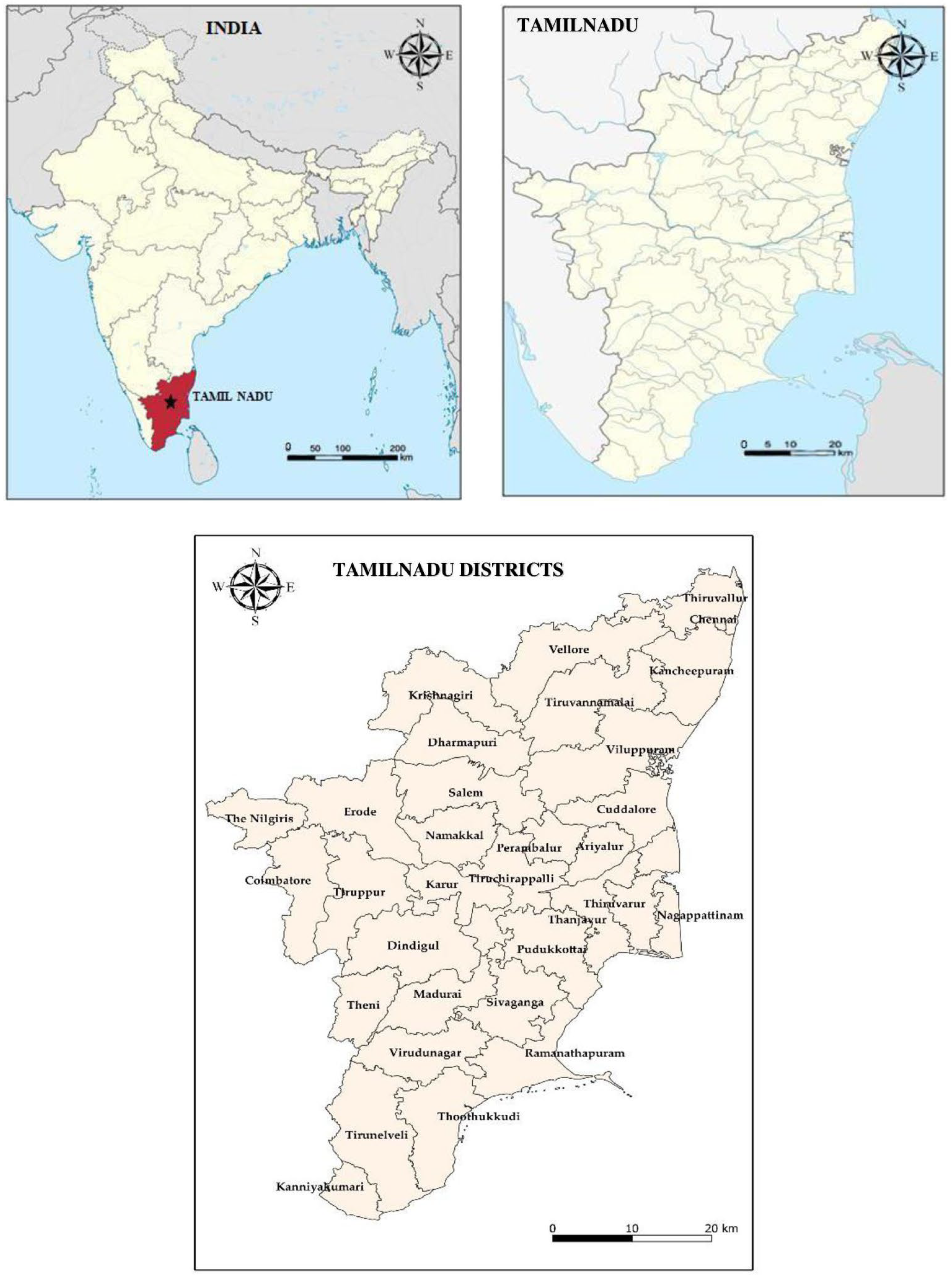
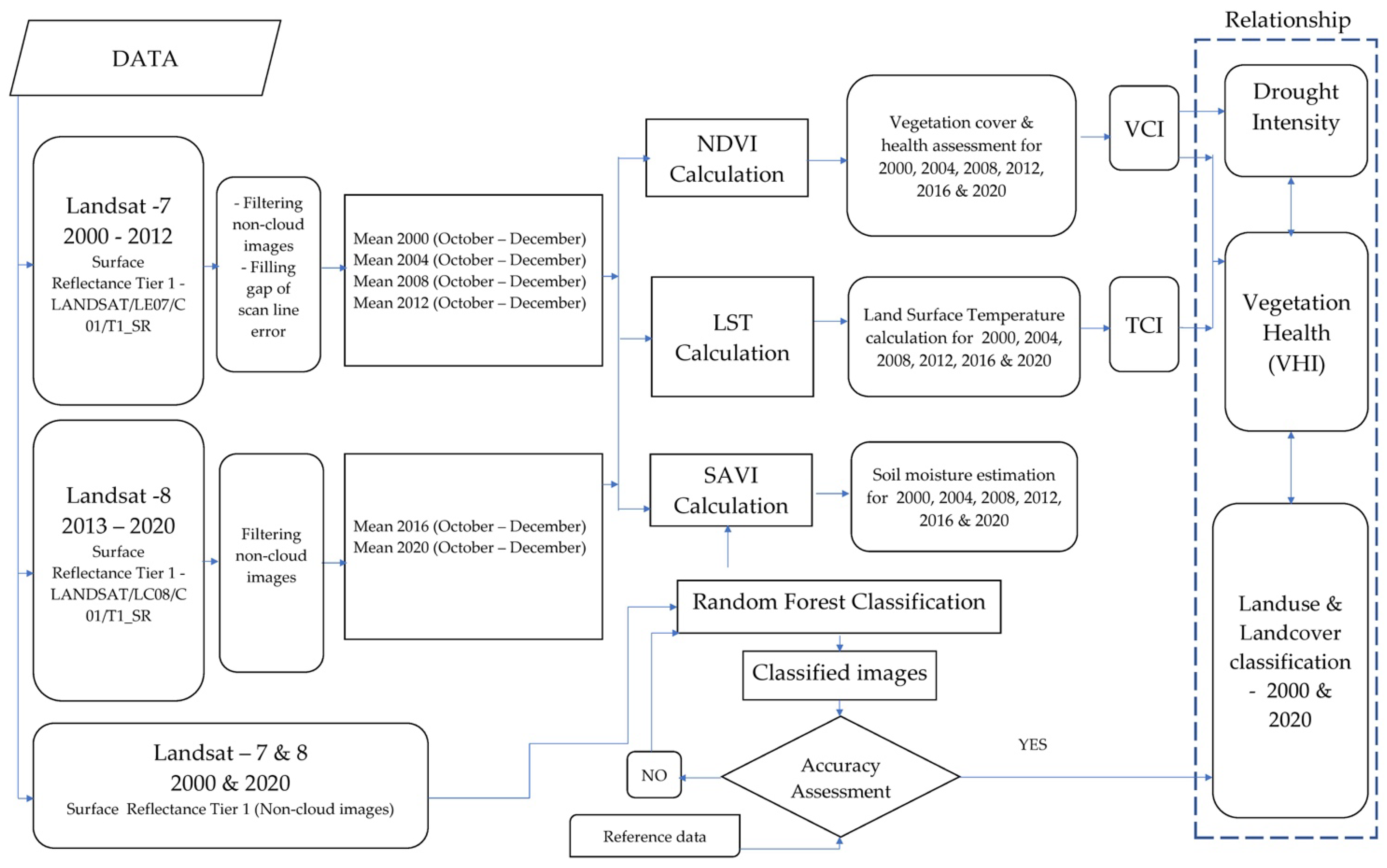
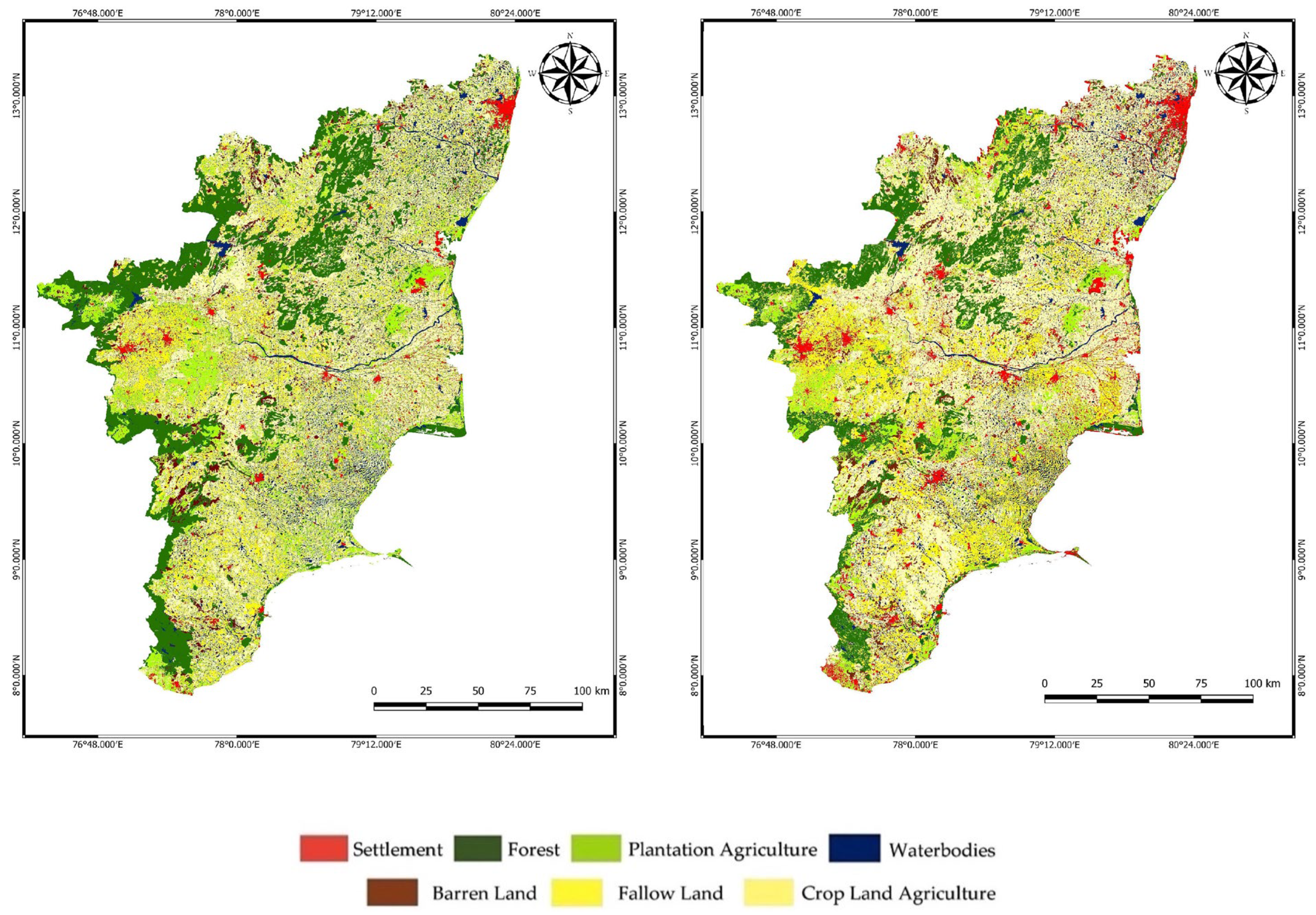
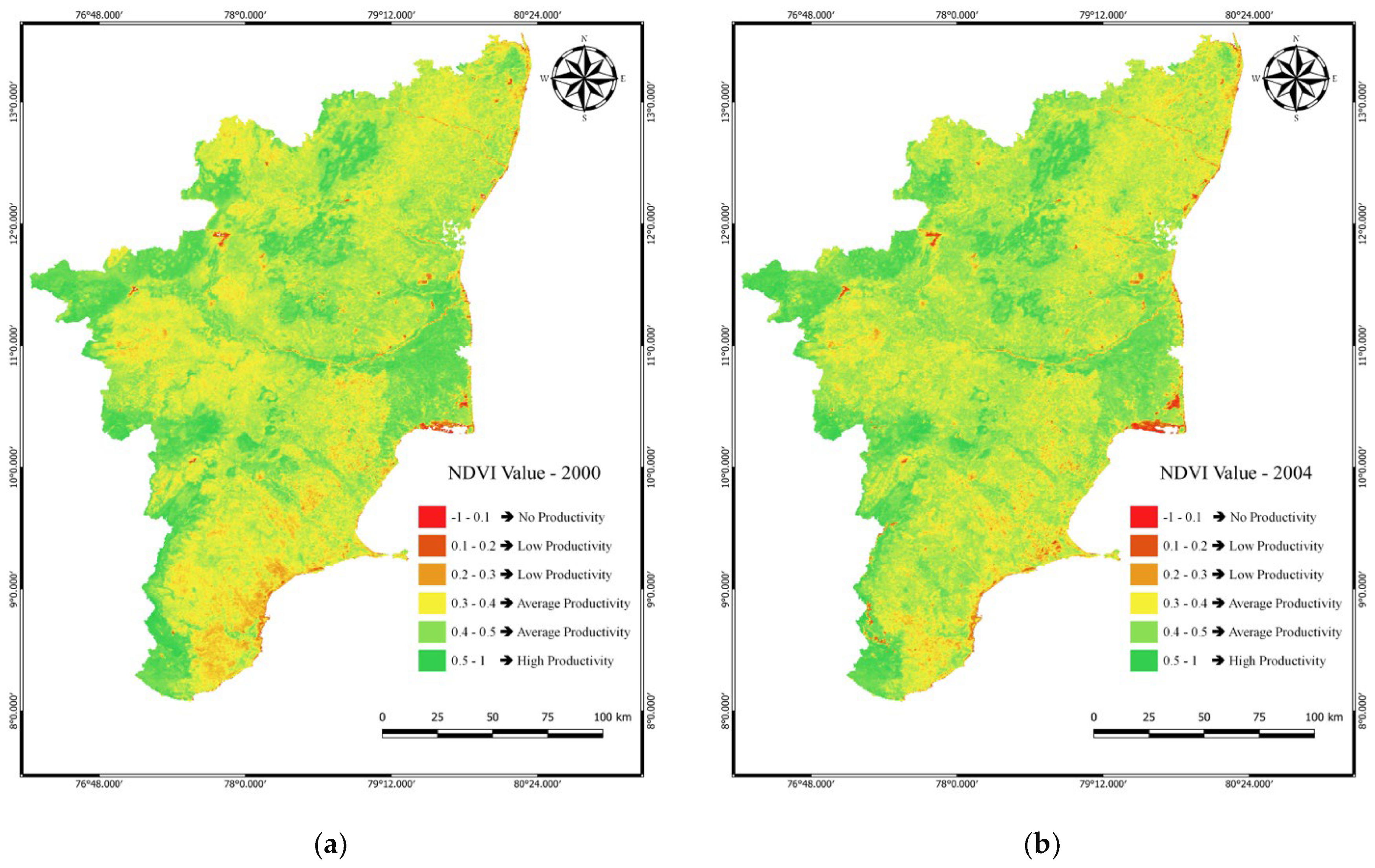

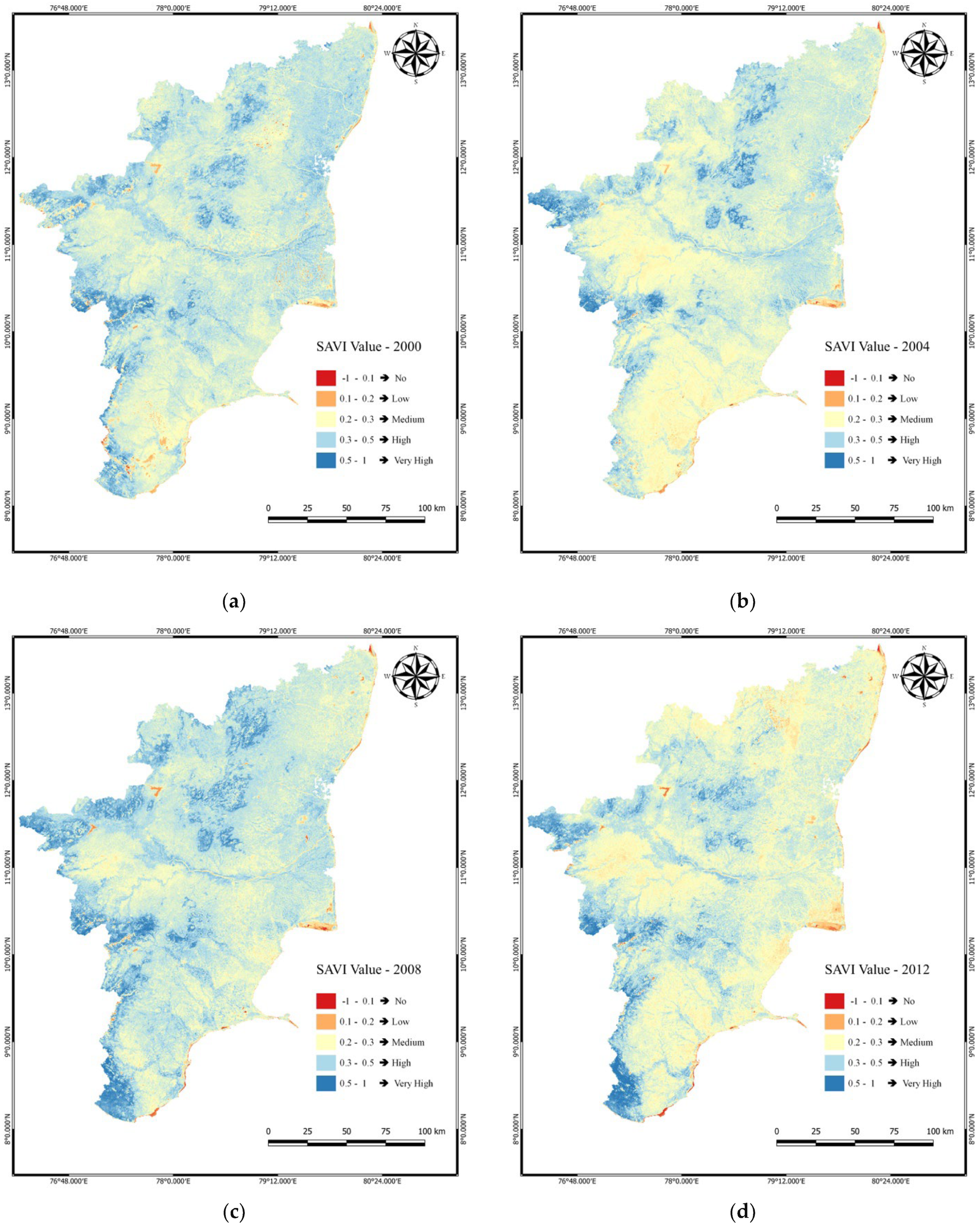
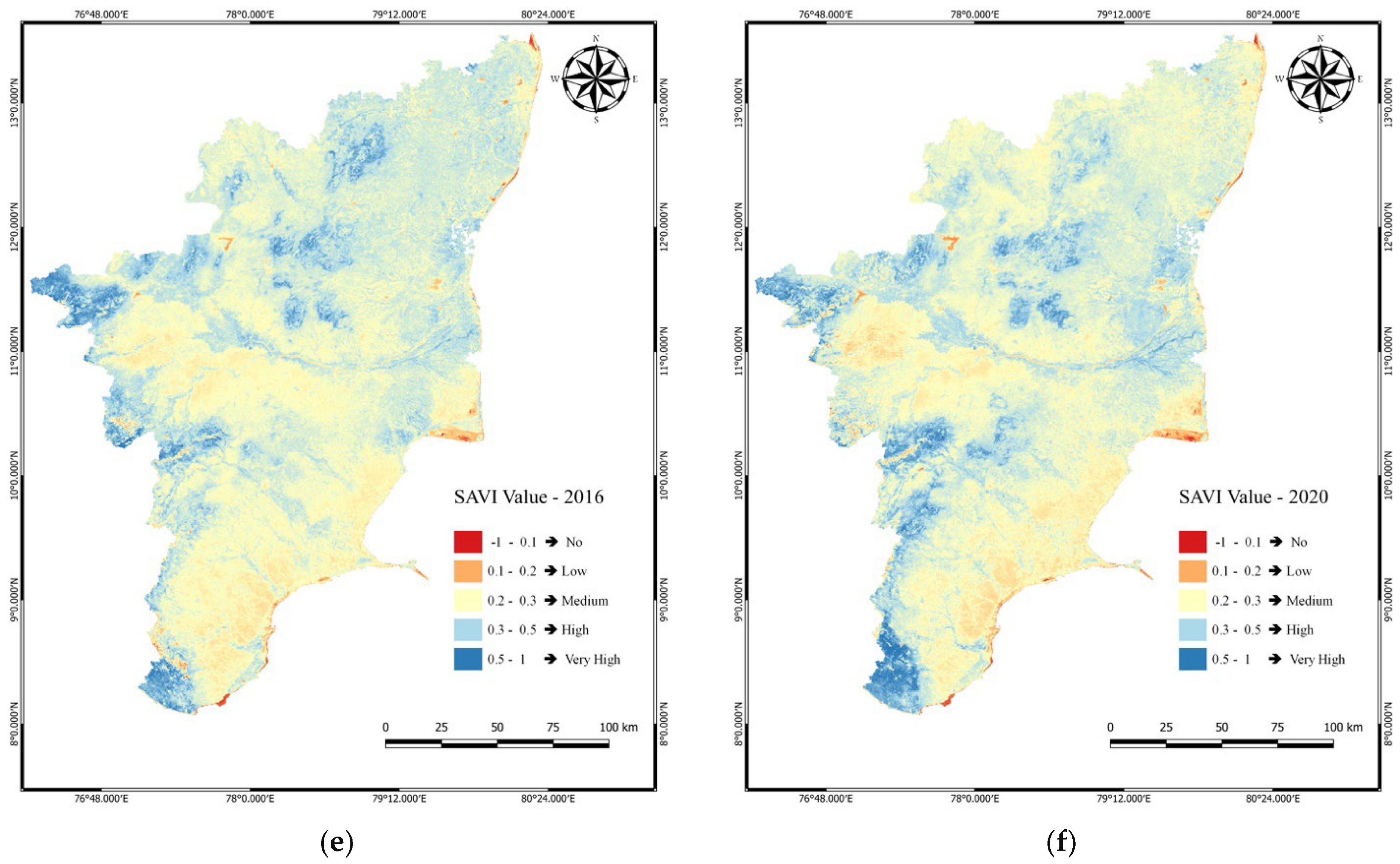


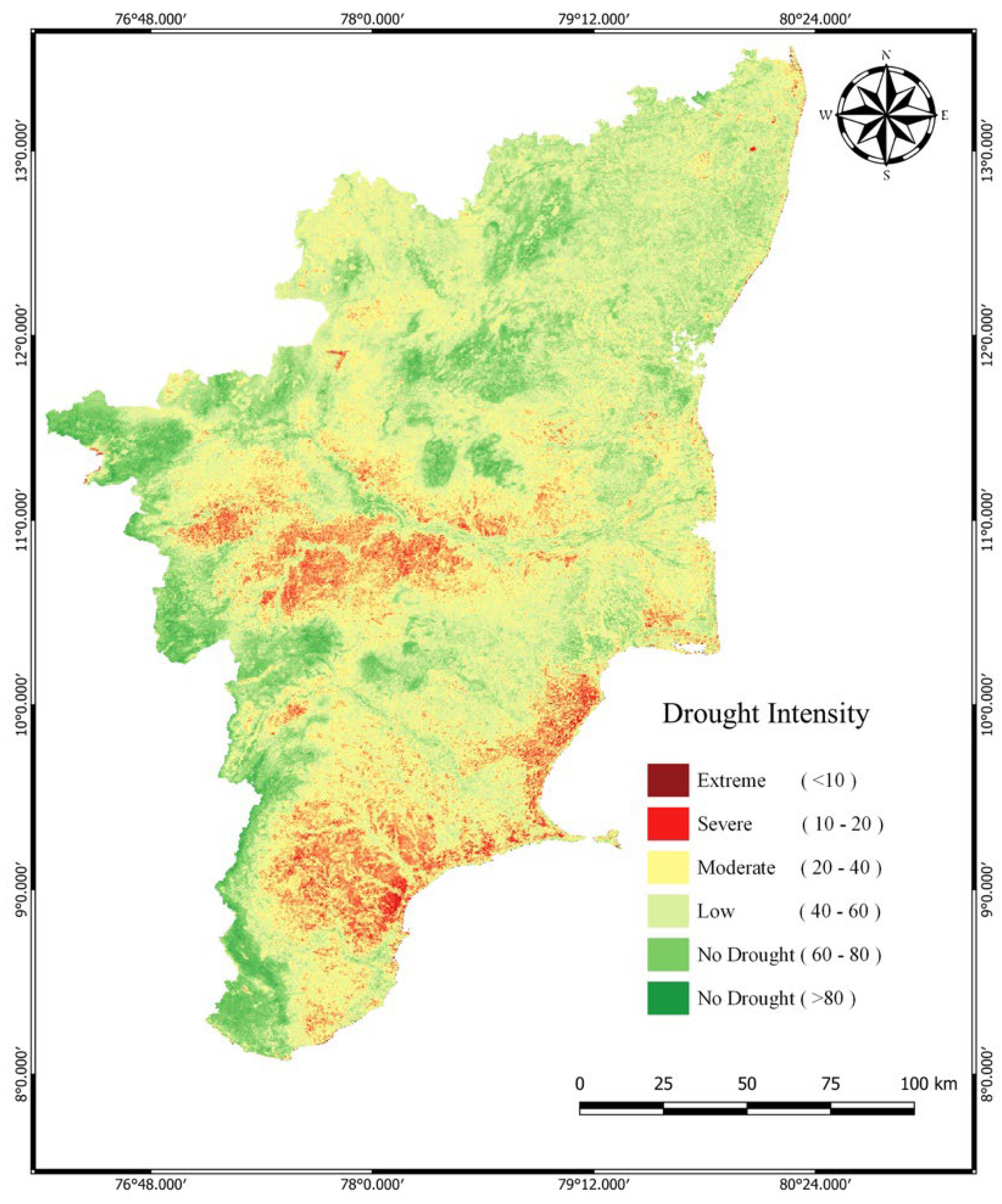
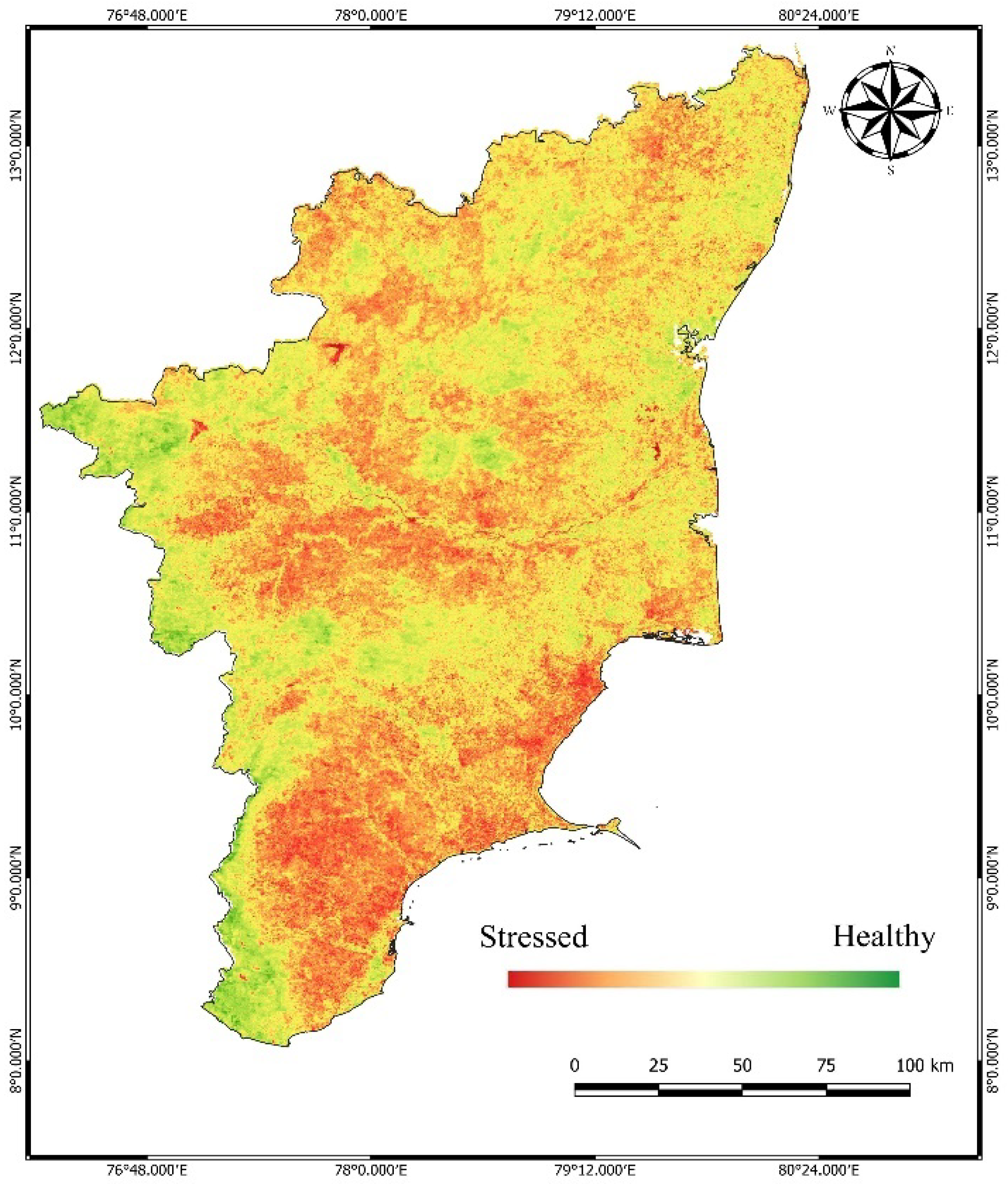
| Name | Spatial Resolution | Temporal Resolution | Date of Acquisition |
|---|---|---|---|
| Landsat 7 Collection 1 Tier 1 TOA Reflectance LE07/C01/T1_SR | 30 m | 16 day | 2000-10-10, 2000-10-17, 2000-10-19, 2000-10-26, 2000-11-04, 2000-11-20,2000-11-27, 2000-12-06, 2000-12-15, 2000-12-20 & 2000-12-29 2004-10-07, 2004-10-12, 2004-10-14, 2004-10-21, 2004-11-08, 2004-11-22, 2004-11-29, 2004-12-01, 2004-12-10, 2004-12-17 & 2004-12-26 2008-10-09, 2008-10-16, 2008-10-18, 2008-10-23, 2008-11-01, 2008-11-03, 2008-11-19, 2008-12-03, 2008-12-12, 2008-12-21 & 2008-12-28 2012-10-04, 2012-10-11, 2012-10-13, 2012-10-27, 2012-11-05, 2012-11-14, 2012-11-21, 2012-11-30, 2012-12-07, 2012-12-14, 2012-12-18 & 2012-12-28 |
| Landsat 8 Collection 1 Tier 1 TOA Reflectance LC08/C01/T1_SR | 30 m | 16 day | 2016-10-07, 2016-10-15, 2016-10-24, 2016-10-31, 2016-11-08, 2016-11-16, 2016-11-25, 2016-12-02, 2016-12-10, 2016-12-18 & 2016-12-26 2020-10-07, 2020-10-15, 2020-10-23, 2020-10-31, 2020-11-08, 2020-11-16, 2020-11-24, 2020-12-02, 2020-12-10, 2020-12-18 & 2020-12-26 |
| No. | LULC Classes | Land-Uses Included in the Class |
|---|---|---|
| 1 | Settlement | Urban, Rural, Mining |
| 2 | Waterbodies | Rivers, Lakes, Ponds, Streams, and Canals |
| 3 | Forest | Deciduous, Evergreen, Scrub Forest, and Swamp/Mangroves |
| 4 | Plantation Agriculture | Agricultural plantation (tea, coffee, and rubber), Horticultural plantation (coconut, citrus fruits, orchards, fruits, and vegetable gardens), and Agro-horticultural plantation |
| 5 | Crop Land Agriculture | Cropped in more than two seasons Paddy, rice, sugarcane, cotton, and groundnut |
| 6 | Fallow Land | Grass dominated land cover, Shrub and bush dominated land cover, and small tree dominated land cover |
| 7 | Barren Land | Bare Exposed Rock, Mixed Barren Land, and Sand dunes |
| Value | Category |
|---|---|
| >40% | No drought |
| 30–40% | Light drought |
| 20–30% | Moderate Drought |
| 10–20% | Severe Drought |
| 0–10% | Extreme drought |
| LULC Classes | 2000 | 2020 | ||
|---|---|---|---|---|
| Producer Accuracy | User Accuracy | Producer Accuracy | User Accuracy | |
| Settlement | 85.06 | 80.21 | 79.14 | 84.27 |
| Forest | 89.12 | 89.95 | 82.26 | 91.66 |
| Plantation Agriculture | 88.75 | 91.64 | 84.59 | 86.74 |
| Barren Land | 93.41 | 86.35 | 86.03 | 88.35 |
| Waterbodies | 89.23 | 94.72 | 86.41 | 86.98 |
| Fallow Land | 92.39 | 84.83 | 87.26 | 92.83 |
| Crop Land Agriculture | 95.62 | 92.15 | 89.35 | 94.16 |
| Kappa | 0.90 | 0.85 | ||
| LULC Class | Area (Sq.km) 2000 | Area (Sq.km) 2020 | LULC Changes 2000–2020 | LULC Changes 2000–2020 (%) |
|---|---|---|---|---|
| Settlement | 5103.29 | 12,721.7 | 7618.41 | 149.28 |
| Forest | 21,954.34 | 17,407.97 | −4546.37 | −20.70 |
| Plantation Agriculture | 9125.72 | 5905.68 | −3220.04 | −35.28 |
| Barren Land | 5385.57 | 11,863.2 | 6477.63 | 120.27 |
| Waterbodies | 9274.63 | 9089.49 | −185.14 | −1.99 |
| Fallow Land | 31,064.4 | 26,997.57 | −4066.83 | −13.09 |
| Crop Land Agriculture | 48,224.51 | 46,173.82 | −2050.69 | −4.25 |
| TOTAL | 130,159.46 | 130,159.43 |
| NDVI Classes | Vegetation Productivity | Area Coverage (km2) | Change in Area Coverage 2000–2004 (%) | Area Coverage (km2) | Change in Area Coverage 2008–2012 (%) | Area Coverage (km2) | Change in Area Coverage 2016–2020 (%) | Change in Area Coverage 2000–2020 (%) | |||
|---|---|---|---|---|---|---|---|---|---|---|---|
| 2000 | 2004 | 2008 | 2012 | 2016 | 2020 | ||||||
| −1–0.1 | No | 6507.97 | 9111.16 | 40.13 | 10,412.75 | 11,714.35 | 12.50 | 18,222.32 | 20,695.35 | 13.57 | 218.00 |
| 0.1–0.2 | Low | 2603.18 | 3904.78 | 50.68 | 5206.37 | 7809.56 | 50.00 | 11,714.35 | 13,146.10 | 12.22 | 405.73 |
| 0.2–0.3 | Low | 1301.59 | 3253.98 | 50.00 | 3774.62 | 4555.58 | 20.68 | 7809.56 | 10,282.59 | 31.66 | 690.00 |
| 0.3–0.4 | Average | 57,270.16 | 50,762.18 | −11.36 | 54,666.97 | 66,381.32 | 21.42 | 67,813.07 | 68,333.71 | 0.76 | 19.31 |
| 0.4–0.5 | Average | 27,333.48 | 29,285.87 | −7.17 | 26,682.68 | 15,619.13 | −41.46 | 10,542.91 | 10,152.43 | −3.70 | −62.85 |
| 0.5–1 | High | 35,143.05 | 33,841.45 | −3.70 | 29,416.03 | 24,079.48 | −18.14 | 14,057.21 | 7549.24 | −46.29 | −78.51 |
| SAVI Classes | Surface Permeability | Area Coverage (km2) | Change in Area Coverage 2000–2004 (%) | Area Coverage (km2) | Change in Area Coverage 2008–2012 (%) | Area Coverage (km2) | Change in Area Coverage 2016–2020 (%) | Change in Area Coverage 2000–2020 (%) | |||
|---|---|---|---|---|---|---|---|---|---|---|---|
| 2000 | 2004 | 2008 | 2012 | 2016 | 2020 | ||||||
| −1–0.1 | No | 71,473.47 | 77,499.89 | 8.43 | 78,610.48 | 83,528.91 | 6.25 | 86,158.26 | 91,253.43 | 5.91 | 27.67 |
| 0.1–0.2 | Low | 6897.59 | 8520.95 | 23.53 | 6024.32 | 8072.63 | 34.00 | 10,349.75 | 12,179.67 | 17.68 | 76.57 |
| 0.2–0.3 | Medium | 7352.34 | 16,824.72 | 128.83 | 5102.44 | 10,412.58 | 104.07 | 13,385.42 | 15,286.84 | 14.20 | 107.91 |
| 0.3–0.5 | High | 21,270.30 | 10,981.54 | −48.37 | 19,301.68 | 12,861.74 | −33.36 | 7039.58 | 4378.71 | −37.97 | −79.41 |
| 0.5–1 | Very High | 23,165.76 | 16,332.36 | −29.49 | 21,120.54 | 15,283.6 | −27.63 | 13,226.47 | 7060.81 | −46.61 | −69.52 |
| LST Classes (°C) | Area Coverage (km2) | Change in Area Coverage 2000–2004 (%) | Area Coverage (km2) | Change in Area Coverage 2008–2012 (%) | Area Coverage (km2) | Change in Area Coverage 2016–2020 (%) | Change in Area Coverage 2000–2020 (%) | |||
|---|---|---|---|---|---|---|---|---|---|---|
| 2000 | 2004 | 2008 | 2012 | 2016 | 2020 | |||||
| 15–20 | 39,325.74 | 36,129.23 | −8.12 | 32,427.97 | 23,257.45 | −28.27 | 18,138.61 | 13,175.31 | −27.36 | −66.49 |
| 20–25 | 29,118.11 | 25,574.10 | −12.17 | 22,142.12 | 18,269.29 | −17.49 | 13,462.45 | 9252.15 | −31.27 | −68.22 |
| 25–30 | 16,134.25 | 15,604.11 | −3.28 | 12,219.51 | 14,367.75 | 17.58 | 17,021.38 | 18,145.74 | 6.60 | 12.46 |
| 30–35 | 20,029.62 | 21,303.74 | 6.36 | 22,401.62 | 23,295.88 | 3.99 | 24,313.57 | 26,372.68 | 8.46 | 31.66 |
| 35–41 | 11,325.36 | 12,335.21 | 8.91 | 14,536.49 | 16,394.36 | 12.78 | 19,149.60 | 21,048.45 | 9.91 | 85.85 |
| >41 | 14,226.38 | 19,213.07 | 35.05 | 26,431.75 | 34,574.73 | 30.80 | 38,073.84 | 42,157.11 | 10.72 | 196.33 |
| LULC Class | Correlation Coefficient | p-Values | |
|---|---|---|---|
| 2000 | 2020 | ||
| Settlement | −0.28 | −0.51 | 0.0061 |
| Forest | −0.06 | −0.11 | 0.0011 |
| Plantation Agriculture | −0.11 | −0.20 | 0.0049 |
| Barren Land | −0.18 | −0.24 | 0.0023 |
| Waterbodies | −0.15 | −0.17 | 0.0017 |
| Fallow Land | −0.17 | −0.27 | 0.0031 |
| Crop Land Agriculture | −0.12 | −0.22 | 0.0048 |
| LULC Class | Correlation Coefficient | p-Values | |
|---|---|---|---|
| 2000 | 2020 | ||
| Settlement | −0.31 | −0.54 | 0.0064 |
| Forest | −0.09 | −0.15 | 0.0012 |
| Plantation Agriculture | −0.12 | −0.22 | 0.0048 |
| Barren Land | −0.20 | −0.26 | 0.0025 |
| Waterbodies | −0.13 | −0.15 | 0.0016 |
| Fallow Land | −0.18 | −0.28 | 0.0032 |
| Crop Land Agriculture | −0.14 | −0.24 | 0.0050 |
Publisher’s Note: MDPI stays neutral with regard to jurisdictional claims in published maps and institutional affiliations. |
© 2022 by the authors. Licensee MDPI, Basel, Switzerland. This article is an open access article distributed under the terms and conditions of the Creative Commons Attribution (CC BY) license (https://creativecommons.org/licenses/by/4.0/).
Share and Cite
Shamsudeen, M.; Padmanaban, R.; Cabral, P.; Morgado, P. Spatio-Temporal Analysis of the Impact of Landscape Changes on Vegetation and Land Surface Temperature over Tamil Nadu. Earth 2022, 3, 614-638. https://doi.org/10.3390/earth3020036
Shamsudeen M, Padmanaban R, Cabral P, Morgado P. Spatio-Temporal Analysis of the Impact of Landscape Changes on Vegetation and Land Surface Temperature over Tamil Nadu. Earth. 2022; 3(2):614-638. https://doi.org/10.3390/earth3020036
Chicago/Turabian StyleShamsudeen, Mohamed, Rajchandar Padmanaban, Pedro Cabral, and Paulo Morgado. 2022. "Spatio-Temporal Analysis of the Impact of Landscape Changes on Vegetation and Land Surface Temperature over Tamil Nadu" Earth 3, no. 2: 614-638. https://doi.org/10.3390/earth3020036
APA StyleShamsudeen, M., Padmanaban, R., Cabral, P., & Morgado, P. (2022). Spatio-Temporal Analysis of the Impact of Landscape Changes on Vegetation and Land Surface Temperature over Tamil Nadu. Earth, 3(2), 614-638. https://doi.org/10.3390/earth3020036









